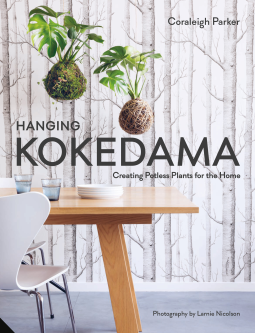
Hanging Kokedama
Creating Potless Plants for the Home
by Coraleigh Parker
This title was previously available on NetGalley and is now archived.
Send NetGalley books directly to your Kindle or Kindle app
1
To read on a Kindle or Kindle app, please add kindle@netgalley.com as an approved email address to receive files in your Amazon account. Click here for step-by-step instructions.
2
Also find your Kindle email address within your Amazon account, and enter it here.
Pub Date Mar 15 2018 | Archive Date May 08 2018
Quarto Publishing Group - Jacqui Small | Frances Lincoln
Talking about this book? Use #HangingKokedama #NetGalley. More hashtag tips!
Description
Marketing Plan
Campaign Focus:
Learn all about the Japanese art of creating pot-less suspended plants, known as kokedama, from New Zealand hanging plant extraordinaire and botanist, Coraleigh Parker
Key Selling Points:
· Ferns, succulents and cacti are now the must-have design pieces of the contemporary interior, and city dwellers are getting more and more creative in decorating their homes with them
· Making kokedama is so easy, children can do it – in addition, making them and looking after them give a real, tactile connection to a plant
· Kokedama offers a means of greening interiors regardless of the changing of the seasons, and they can be moved around until the perfect spot is found
Key Campaign Activity
· Marketing and publicity campaign at gardening media
· Giveaways at Goodreads and select gardening media
· Include in Quarto B2C and B2B campaign
· Create sell-sheet for specialty sales accounts
Publicity/Media:
· National gardening and related media: Horticulture Magazine, Garden Design, American Gardener, Coastal Living Better Homes and Gardens, Southern Living, Nature’s Garden, Birds & Blooms, Country Woman, Fine Gardening, Mother Earth Living, Sunset Magazine, Living the Country Life, Garden Gate, Organic Life, Garden Design
· Daily Newspapers with home & gardening coverage – Major Markets: Dallas Morning News, Associated Press, Wire services: Knight Ridder, Tribune Media Services, Chicago Tribune, Houston Chronicle, Sacramento Bee (heavily syndicates gardening content to multiple markets), Miami Herald, Philadelphia Inquirer, San Francisco Chronicle, Los Angeles Times (heavily syndicates gardening content to multiple markets), Pittsburgh Post, Minneapolis Star Tribune (heavily syndicates gardening content to multiple markets), Arizona Star, Denver Post, Atlanta Journal Constitution
· Regional Magazines with Gardening Coverage: Midwest Living, Southern Living, Sunset, Northern Gardener,
· Concentrate and target interior decorating bloggers, outlets, domestic lifestyle and upper demographic audiences
· Garden Center/Wholesalers media: Green Profit, Grower Talks, Nursery Management, Floral Management
· Blogs and Websites: Grumpy Gardener, GreenGirls, GardenRant, Dallas Life Blog, Empress of Dirt (Canada), In the Garden , Gardenista, Garden Therapy, Kiss The Earth, Penn Live Blog, Diggin’ In, HGTV Garden Blog, Life on the Balcony, Let's Get Dirty, Gardening Gone Wild
· Book Trade: Library Journal, Publishers Weekly, Booklist, Bookish, Shelf Awareness
· Radio – Local & Syndicated Programs: You Bet Your Garden/Philadelphia (and national NPR syndication), Bob Tanem In the Garden/ San Francisco, Garden Talk/San Francisco, Joy In the Garden/Vermont, In the Garden/Memphis, Mike Nowak/Chicago, Garden Life Radio
· Trade Review: Library Journal, Publisher's Weekly, Booklist, Bookish, Shelf Awareness, Kirkus, BookTrib
Available Editions
| EDITION | Other Format |
| ISBN | 9781911127390 |
| PRICE | $30.00 (USD) |
| PAGES | 144 |
Average rating from 13 members
Featured Reviews
 Librarian 76706
Librarian 76706
Stunning photographs and beautiful floral design and styling. This book was so inspiring and definitely a must read for any plant enthusiast. Minus one start though since the instructive part was not very clear in creating these which is a primary function of what I believe the author was trying to do.
 Amy M, Librarian
Amy M, Librarian
Hanging Kokedama by Coraleigh Parker is an excellent book of "string plants," "moss ball plants," or other similar named hanging plants that are actually Kokedama, plants wrapped in moss and then tied with string to be able to hang without a pot. They are very unique, trendy, and awesome! This book has lots of ideas, big and small, to try with full color photo instructions. Definitely recommend this book to add to the collection of those interested in gardening projects.
 Pam S, Reviewer
Pam S, Reviewer
I'm a crafter as well as a reader,so I look for creative solutions for home decoration as well. This book got my attention with its 'potless plants' phrase.
It didn't disappoint me at all. It's about how to create potless plants at home that looks very interesting, elegant and decorative. I personally don't like big pots of flowers at home, so this was really good to learn.
The book separates the plants into categories and teaches you how to make them step by step with pictures as well. I liked the selection of plants, nice, elegant, small and easy plants, both green and with flowers.
The instructions are very easy, and visuals help a lot. I would definitely recommend to people who're interested in interesting home design, it's very creative and good looking.
Thanks to the publisher and Netgalley for granting a copy in exchange for an honest review.
 Leyla J, Reviewer
Leyla J, Reviewer
Hanging Kokedama seems to be a growing rage, here in Australia at any rate, I have seen it done and it can look very effective, and in some cases quite crazy, by using unique binding such as florescent or other colours.
Kokedama as the opening pages say it is a "Japanese art of creating pots less plants using a unique soil, mix, moss and string" the results are very organic and can be used with many plants.
The book explains the technique very simply and easily followed - the results are quite beautiful - even an olive tree can be treated in this manner and hung in a lounge room. The book separates species into chapters with cacti, ferns, tropical plants, bulbs, herbs and more. Each has an explanation and profile of the plant including care.
The book is very informative and really easy to understand and a good beginning to creating fabulous living hanging gardens.
 Lili F, Reviewer
Lili F, Reviewer
What a fun way to have houseplants! I am a known houseplant killer, granted one of the big deaths for my houseplants are my cats, so having them hanging away from the fuzz balls just might work! Plus it is just a great aesthetic, having baskets (it reminds me of weaver bird nests) full of plants hanging around is beautiful and delightfully soothing. The instructions on how to create these plant nests is very clear and simple, I look forward to trying them out!
 Reviewer 378331
Reviewer 378331
This book is lovely, it has a lot of big pictures that made me dream about all the different plants I want to hang from my ceiling, next to the window or beside my reading spot. I used to have a very general idea of kokedama: "a ball of soil covered in something that keeps the soil together and twine all around it, used for ferns and those kind of plants" but oh I was wrong! so wrong. First of all, there is a methodology and a reason for each material used when making a kokedama. Second, *get ready for it* you can even create kokedama trees and seasonal plants!.
Most of the book focuses on instructions for making and maintaining kokedama of popular plants, organized by categories such as tropicals, succulents and cacti, tress and shrubs, herbs, bulbs, corms and tubers, epiphytes and of course, ferns. Each "plant profile" comes with scientific and common name, light, water and food requirements, growing speed and conditions, if it is pet friendly, most common concerns and a soil recipe that best fits that plant. There's a list at the end of the book with online suppliers from around the world (in case you have same problem as me and can't find the materials from your local shop and don't dare to ask the neighbor for their wild growing moss.)
*I requested an eArc from Jacqui Small LLP in exchange of a fair review Thank you!
 Reviewer 446033
Reviewer 446033
#HangingKokedama #NetGalley #GreenUrban
The Kokedama are trendy and gives a green accent to any room of the house. The techniques are interesting and the results are beautiful.
 Alexis A, Reviewer
Alexis A, Reviewer
I had no idea hanging plants in self-made pots like this was even possible before reading this. This really expands the ability of hanging plants without tacky pots, or making a strong conversation piece for your home. The process of making the root ball looks simple enough, but unfortunately, locating some of the ingredients needed has been a little difficult. Once I can find the ingredients needed, I look forward to making my own, given the simplicity of the instructions and the many different plant types the book recommends using. Give this a look even if you just want to learn how the root balls are made.
Readers who liked this book also liked:
We Are Bookish
Historical Fiction, Literary Fiction, Multicultural Interest







